by Editor | Feb 13, 2012 | Attractions, Ecotourism, New Articles
Article and photos by Elena del Valle

Dominica is lush and tropical
For most people thoughts of a Caribbean island stay bring forth visions of a vacation spent lazying on powder white sand beaches, gazing at turquoise waters and drinking rum punches served beachside with cute paper umbrellas. One of the reasons I liked Dominica was because it was, for the most part, devoid of such attractions. The highlights of my week long visit to Dominica, a lush green underdeveloped island, without luxury or chain hotels, sandwiched between Martinique and Guadeloupe in the eastern Caribbean, were centered around the island’s natural landscapes and beautiful views.

With the help of Justine, my guide from the Jungle Bay Resort & Spa, I hiked to Victoria Falls
For the active minded there were waterfalls, lakes, hiking paths, and hot springs to discover. As a nature lover I liked the possibility of spotting indigenous fauna and exploring the greenery within hundreds of miles of hiking trails that traversed the island. During my off season visit in addition to hiking, I visited waterfalls, a beach, a gorge, lakes, and rivers. One night after dinner at the pretty Rosalie Bay Resort, I was lucky to see turtle hatchlings crawl from the beach to the Atlantic Ocean.

Kurnel Simon, native guide and driver
With the services of Kurnel Simon, a native guide and driver, (Transcendent Tours 3222 Canal Hill, Massacre, + 767 449-3969, kurnicb5@hotmail.com) I saw some of the island’s best known attractions. His patient demeanor, excellent driving skills (driving, on the left along narrow two lane roads, required a sportsman’s attitude in Dominica where many of the roads were under repair or in need of repair) and can do attitude enhanced my experience. Because it was off season the island was pleasantly quiet.
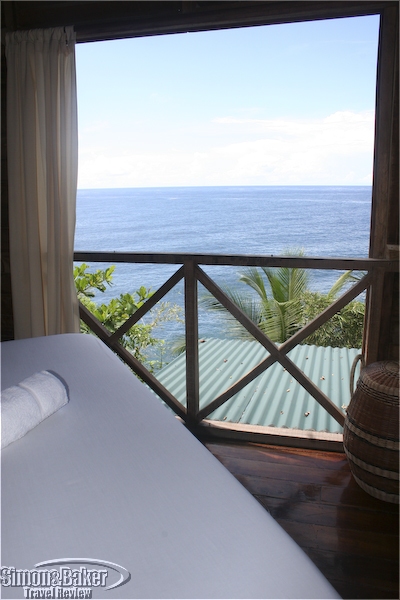
The spa at Jungle Bay looked out on the Atlantic Ocean
In terms of accommodations, I divided my time between the east and west coasts on the southern end of Dominica. First I stayed at the Jungle Bay Resort & Spa at Pointe Mulatre. Although there were many things I enjoyed at the ocean front hill property the one that will stay with me the longest was the sound of the pounding surf from the comfort of my non air conditioned room (the lack of noise from an air conditioner made it possible to hear the sounds of the surf clearly), poolside and at the water facing restaurant.

There were many hiking trails in Dominica
Justine, a native of a nearby village, was my guide on a four hour hike to Victoria Falls organized by the Jungle Bay staff. Although the hike tested my resolve more than once and served to showcase Justine’s patience it was a worthwhile way to discover that part of the island. We encountered no souls during the hike and the only sounds we heard were those of nature, the river and the waterfalls.
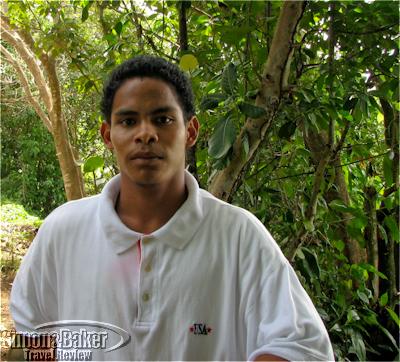
My guide in the Carib Cultural Village by the Sea in Kalinago Barana Aute
To reach the falls, it was necessary to traverse through natural trails, mostly unmarked and often slippery, through pebble and boulder strewn areas, and cross the Victoria Falls River on foot numerous times through strong currents that reached waist high more than once. I fell multiple times although the only major injury was to my pride. Thanks to Justine’s kind nature and our joint perseverance we made it to the edge of the falls (the rocks at the end segment were too steep except for billy goats in human guise and Justine) and back.
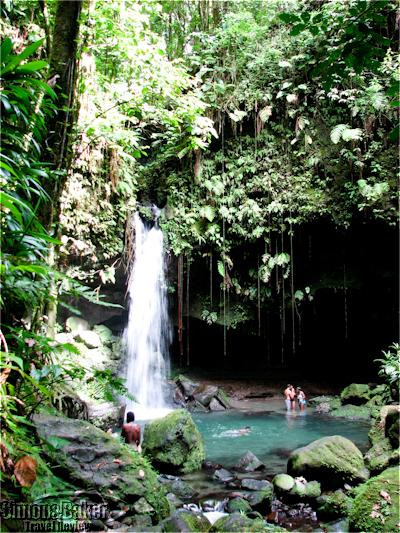
The Emerald Pool was a popular swimming and tourist destination
The next day was dedicated to the Emerald Pool and the Carib Cultural Village by the Sea within the Kalinago Barana Aute (Crayfish River, Carib Territory, +767 445-7979, fax +767 445-7533, www.kalinagobaranaaute.com, kbamanager@cwdom.dm) on the eastern coast of the island. Sunday was consumed with tours of the Cabrits National Park and the scenic Indian River followed by a drive through Portsmouth, the second largest town on the island, and a hunger satisfying beachfront lunch at Le Flambeau Restaurant at the Picard Beach Hotel on the northwest corner of the island. I took a moment to walk out on the dock in front of the hotel and made a mental note to return to that part of the island if ever I had a desire for an understated beach with clear water. On our way south to Roseau, the capital where I would stay for the remainder of my visit, we drove along the scenic coastal road.
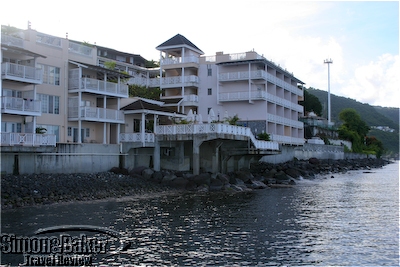
The Fort Young Hotel is on the water
After checking in at the waterfront Fort Young Hotel in the heart of town, I had an early dinner. The following day, I visited the lovely Trafalgar Falls, the Freshwater Lake and Titou Gorge. Mother Nature scheduled nonstop rain all day, helping to keep the island verdant. Because the Lake was enveloped in thick fog and it was chilly we minimized our time there. We carried on with most of the itinerary although we discovered Screw’s Sulfur Spa, the last stop for the day, was closed that week. We attempted to visit another hot spring facility at the last minute with little success.

One of many Waitukubuli National Trail signs
The Waitikubuli National Trail was the island’s claim to fame for hiking. A 3.5 hour hike of Segment 1 of the Trail from Scotts Head to Soufriere was scheduled for the next morning. We were slightly delayed due to some difficulty locating my hiking guide. After collecting him at a nearby village Kurnel Simon dropped us at the beginning of the hiking trail and we set off on the “easy” hike. Although I felt pleased with myself at the end of the hike it confirmed what I suspected following the Victoria Falls hike: that what the Dominicans described as an easy hike would be considered challenging or difficult for me and most of the hiking aficionados, save the most fit and hard core, I know.
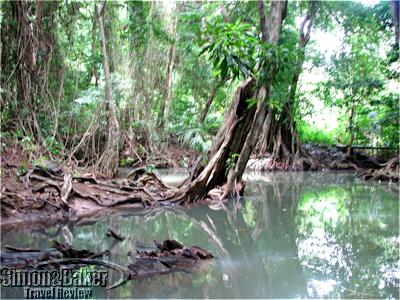
The famed Indian River
Snorkeling the next morning was canceled at the last minute by the snorkeling company. Since we had little time to make alternate plans before the afternoon whale watching excursion we visited the botanical gardens and drove up the hill to enjoy a panoramic view of Roseau.
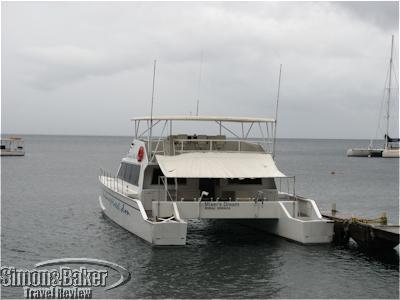
A vessel of the Anchorage Whale Watch & Dive Center
We went whale watching with Anchorage Whale Watch & Dive Center (The Anchorage at Castle Comfort, P.O. Box 34, Roseau, +767 448-2638, fax +767 440-2639, www.experience-dominica.com). After a safety briefing and discussion on whales and dolphins at the hotel where the company operates its tours, 14 of us, 11 passengers and three crew members (Captain Francis Charles, Dave Fabien and Eddie Joseph), went aboard the Miser’s Dream. The 60-foot catamaran motorboat built in 2000 and licensed for a maximum of 50 passengers was comfortable and spacious. Although we struck out on whales (which they see 80 percent of the time, according to the crew) we were delighted to come across spinner and spotted dolphins, a less common find in those waters. After motoring north and south along Dominica’s west coast some three miles from shore and spending 90 minutes under gray and heavily overcast skies we returned.
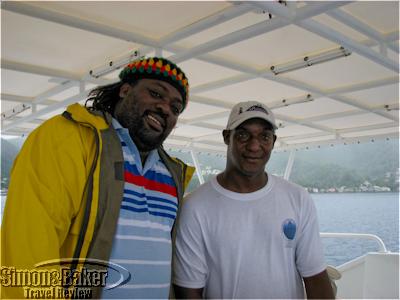
Crew members aboard the Miser’s Dream
Discovering the island’s natural treasures drew me to Dominica for the first time. Its stunning natural scenery, off the beaten track unspoiled character, genuine locals, simple organic meals and the possibility of discovering more of the Nature Island’s hidden beauty including some water attractions like snorkeling, diving and a second try at whale watching would draw me back.
by Editor | Feb 6, 2012 | Accomodations, Attractions, Ecotourism
Article by Laura Scheiber
Photos by Matthew Harris
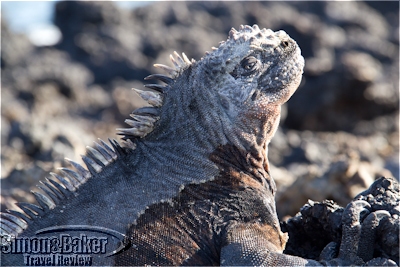
Galapagos marine iguana on the islet of Las Tintoreras
In October, my travel partner and I went to the Galapagos Islands, a UNESCO World Heritage natural site. We found the islands to be a fascinating place because of the unique wildlife. Throughout our trip we saw a myriad of animals that exist nowhere else on the planet, the outcome of adapting to the unique conditions of these isolated islands over millions of years. It was easy to understand why this “natural laboratory” inspired Charles Darwin’s theory of natural selection and evolution.
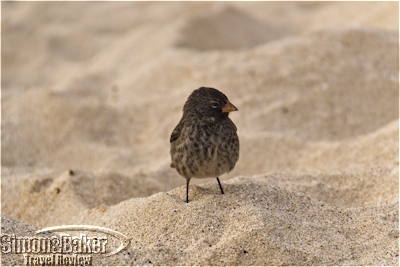
Small ground finch, in Garrapatero Bay on Santa Cruz Island
After traveling to Ecuador, getting to the Galapagos Islands entailed an hour and a half flight from Guayaquil, Ecuador. Our land-based tour lasted six days, hopping between Santa Cruz Island, Floreana Island and Isabela Island. From the moment we landed, we noticed that the islands were teeming with wildlife. We spent our first afternoon on the white sandy beaches of Garrapatero Bay on Santa Cruz Island watching pelicans fish in perfect synchrony, while cheeky finches hopped on our legs, attempting to steal a bite of bread from our lunchtime sandwiches.
Throughout our trip, there was wildlife even in the most mundane places. While waiting for a boat on Floreana Island, for example, we shared the dock with sea lions basking in the sun, pelicans overlooking the sea and a curious iguana that wanted to get a closer look at our camera.
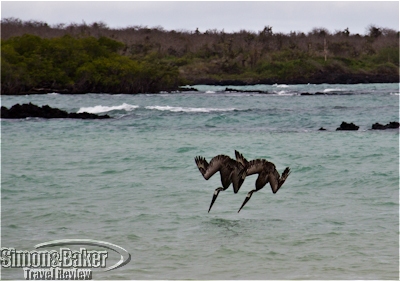
Pelicans fishing in Garrapatero Bay on Santa Cruz Island
Our most memorable encounters were with the famous giant Galapagos tortoises. Weighing up to 500 pounds and measuring 1.5 meters in length, it was amazing to think that some were over 130 years old and had lived during Queen Victoria’s reign, two world wars, the invention of computers and spaceflight. Most of the time these gentle giants were content munching slowly on grass, but we unexpectedly came across two tortoises having a particularly “romantic” moment at the Rancho Primicias tortoise reserve on Santa Cruz Island. I will never, ever, forget those prehistoric sounds.
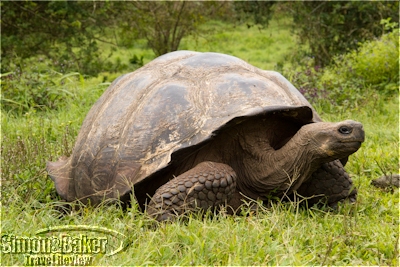
Giant tortoise at Rancho Primicias, Santa Cruz Island
An especially distinctive place that we visited was Las Tintoreras, just off of Isabela Island. Made of lava rock, the islet had a moon-like appearance, made even more surreal by the hundreds of marine iguanas piled on top of one another. These lizards were a good example of evolution in action. In order to survive they have evolved to be semi-aquatic, eating marine algae and staying under water for up to one hour without air.
Las Tintoreras also had a lava-made water channel about three meters wide, where at least twenty white-tip reef sharks rested. Other highlights included snorkeling in crystal clear turquoise water where a sea lion circled my travel partner, and a green sea turtle gracefully swam past me. As we headed back to Isabela Island, we saw some blue-footed boobies, famous to the Galapagos Islands, standing on some rocks.
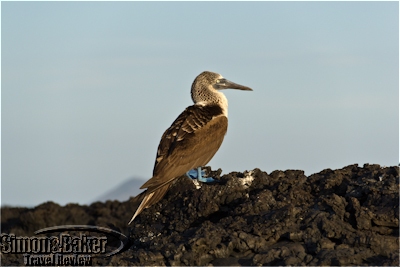
A blue-footed booby near Isabela Island
Because 97 percent of the Islands are part of the Galapagos National Park, visitors must be accompanied by an accredited naturalist tour guide. To be licensed by the Directorate of the Galapagos National Park, these guides had to first pass an intensive course followed by a difficult exam. We booked our land based trip, Darwin’s Triangle Long 3 islands tour, with Red Mangrove Galapagos & Ecuador Lodges (Avenida De Los Shyris 344 y Eloy Alfaro, Edificio Parque Central, Oficina 503, Ecuador, + 593 2 382 3941 or + 888 254 3190 for toll free calls from the United States, http://www.redmangrove.com/, salesteam@redgalapagos.com). Red Mangrove contracted Duncan Divine, who provided interesting and informed context to the fauna and habitats we observed, on our behalf.

Duncan Divine, our excellent naturalist guide
Since we wanted to see as much of the wildlife as possible, we were pleased that the Red Mangrove itinerary was well-organized and packed full from morning to evening. We spent the first and last evenings on Santa Cruz Island, one night on Floreana Island and two nights on Isabela Island. We were busy during the days visiting tortoise reserves, volcanoes, going on hikes, snorkeling (Red Mangrove provided equipment and wetsuits for the 65 degree water) and relaxing on white sand beaches with turquoise water.
We liked the Red Mangrove tour because it was a well-organized land-based trip and offered a socially responsible approach to tourism on a medium-priced budget. The staff were exceptionally friendly and the accommodations were clean and comfortable. All of the lodges on our tour were oceanfront properties and the rooms included shampoo, conditioner, and shower gel from a dispenser, as well as hand soaps, a blow dryer, a glass jar full of drinking water, and security box. Most of the meals were buffet style, and the lunches and dinners included a fish, meat, and vegetarian dish, several salads, a soup, and desserts.

The Jade Room at Aventura Lodge on Santa Cruz Island, Red Mangrove Galapagos & Ecuador Lodges
Overall our trip to the Galapagos Islands was an unforgettable experience thanks to the unique animals that we were able to see at close range. I would recommend a trip to friends and family who love wildlife and the Red Mangrove Galapagos tours for those who prefer a land-based tour with an emphasis on environmentally friendly tourism over luxury.
by Editor | Dec 12, 2011 | Accomodations, Ecotourism, New Articles, Video
Article, video, music and photos by Joachim Castellano
Travelers in Japan have the opportunity to stay in ryokans, traditional Japanese inns. Typically ryokans involve sleeping on the floor in tatami-matted rooms, bathing in a communal bath, and consuming an excellent Japanese dinner and breakfast included with the room charge. Recently while traveling in Izu, an area of Japan famous for its ryokans, I stayed at Arcana Izu (the hotel writes it arcana izu all in lowercase letters), a luxury ryokan that blends the traditional Japanese ryokan with Western concepts.
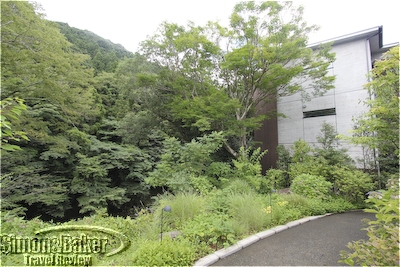
Arcana Izu blends modern architecture with the nearby Kano river
The fusion of East and West began with its name. Arcana is Latin for mysteries. Furthermore, Arcana Izu bills itself as a luxury auberge, and the hotel had a noticeable French influence, exemplified most by its Lumiere restaurant. After my taxi driver pulled into a stony entrance barely visible from a windy, rustic road, it seemed like I had discovered a secret place in the mountains.

High quality Thann body wash, shampoo, and conditioner
How had this mysterious and luxurious inn in Japan come to exist? Three Japanese entrepreneurs collaborated to create it: A French chef, a designer, and a graphic artist. Good design is about making tasteful choices. And almost every detail at the hotel revealed a discriminating eye, starting with its picturesque location near the Kano River.
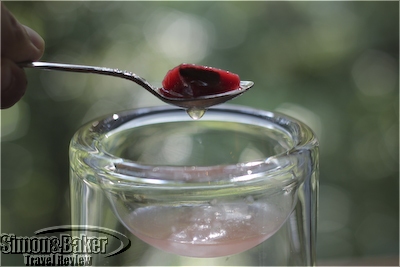
I was delighted by the chocolate center of this berry treat
I was greeted by name at a large entrance gate, and ushered into River View Suite Number 5. A hotel butler checked me in inside the room itself, as there was no traditional front counter. Besides confirming the details of my stay, my butler briefly explained the amenities of the room and asked my preferred dinner and breakfast times. Another staff member entered the room and served me a welcome treat of bubbling fruit juice, ice-chilled berry, and a cookie.
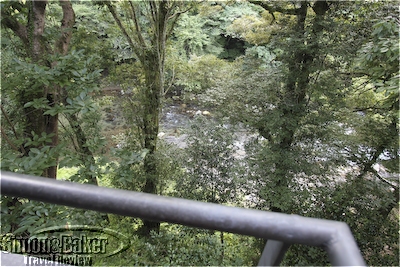
A view of the Kano River
Check-in completed, I had a chance to consider my room while sipping the welcome drink. I was awestruck by the incredible view before my eyes: tall door-length windows wrapped around the room, showcasing Mount Amagi’s lush forest across and a rushing Kano River below my room.

An instruction card suggested drawing and painting techniques
To the left I spotted Arcana’s hallmark feature, an outdoor private hot spring bath. This bath was connected to my room via the bathroom, which had three sections. My room was the smallest room offered at Arcana Izu, yet I didn’t feel cramped at all; the room was spacious and modern.

From the hot spring bathtub, I could view of my room and the river below
During my stay I felt relaxed and rejuvenated. The staff were friendly, attentive, and easy to communicate with. Soaking in the views of nature from my bath and from my room soothed my city-worn spirits. Staying at Arcana Izu even inspired me, a technology addict, to include more nature-related breaks in my daily life.
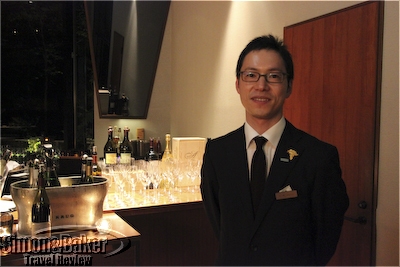
Shinjiro Kobayashi, the sommelier, guided me through Arcana Izu’s twelve-page wine menu
Next time, I’ll be sure to bring along someone special to share in the wonderful secrets of this magical ryokan. The total experience, the private bath, the view, the French food, and the excellent service added up to artistry in action, a masterpiece in the mountains called Arcana Izu.
by Editor | Nov 7, 2011 | Attractions, Ecotourism
Article and photos by Elena del Valle
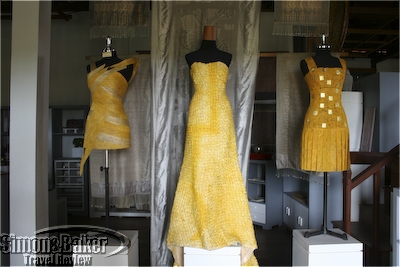
High fashion dresses were on display in the shop
One of the off the beaten path activities I most enjoyed during a trip to Siem Reap, Cambodia this year was a tour of the Golden Silk Pheach farm, about an hour away from the city. As soon as I found out about the farm I was intrigued. With the help of the staff at my hotel I scheduled a guided visit. This required advance planning as visits, with the owner, were strictly by appointment.

Oum Sophea Pheach explains the process of creating silk fibers
What impressed me about the Golden Silk Peach, before even visiting the farm and store, was the sheer dedication and determination of its owners. Oum Sophea Pheach, a Cambodian and former director of the National Center of Cambodian Silk, and her husband Patrick Gourlay, a French banker, had the vision to manufacture rare fine golden silk in their own farm. In 2002, they created the project from the ground up, funded the farm 32 kilometers from Siem Reap and trained 100 staff (many of them young and disadvantaged rural residents).
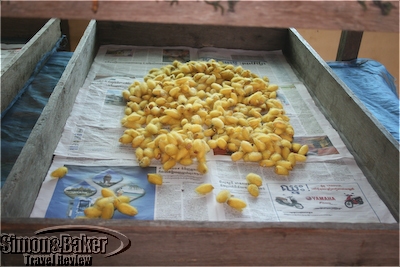
The deep golden color produced by the silk worms
It would be nine years before the first silk production was successful. Visiting the farm and watching the staff at work was a learning experience. The painstaking process required time, skill and patience. A single unique silk fabric could take months to manufacture.
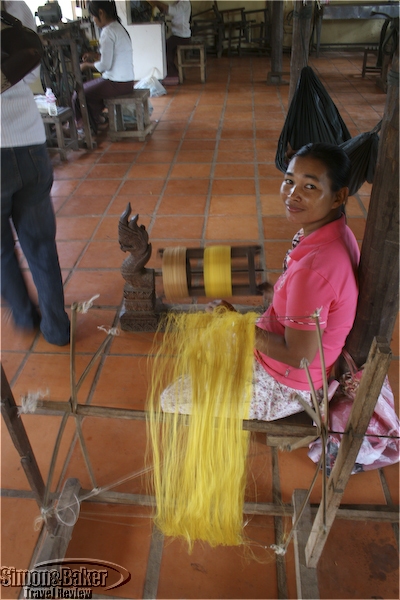
The next stage is to make thread from the silk
Visiting the shop was an exercise in restraint. In addition to fine silk textiles and silk products made at the farm, the shop sold art (sculptures, stone, wood, bronze and cotton items) produced in the area. The Golden Silk ikat designs and colors varied; prices ranged from $50 for a basic scarf to $1,200 for an elegant silver gray wrap I fell in love with and as much as $15,000 for an elaborate large wrap.
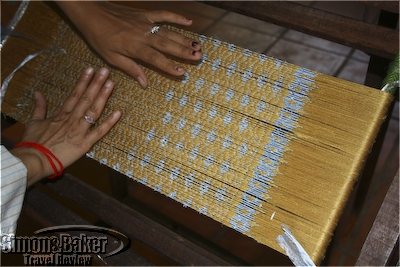
The cloth is woven by hand
For tourists who couldn’t spare the time to drive to the farm and wished to see the silk products the owner offered private display and sales at her home (by appointment only), a handsome and lovingly built property in one of the most exclusive neighborhoods of the city. We stopped there after the tour of the silk farm. Golden Silk Pheach (+855 (0) 12 59 68 11, sophea@goldensilk.org, http://www.goldensilk.org)
by Editor | Oct 31, 2011 | Accomodations, Ecotourism, Luxury Travel
By Elena del Valle and photos by Gary Cox
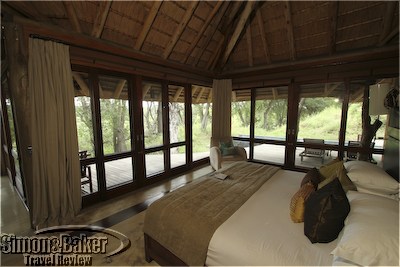
Suite 2 at Leadwood looked out into the bush
During a visit to South Africa’s famous Sabi Sand Reserve earlier this year we stayed at three &Beyond properties, Dulini and Leadwood at the Exeter Reserve and Kirkman’s Kamp on the southeastern corner bordering http://simonandbaker.com/kruger. While each had a charm of its own, Leadwood was the most intimate and luxurious, our favorite. One of the reasons it captured our hearts, in addition to fine suites with private plunge pools, contemporary stylish décor, an emphasis on privacy and top notch service and meals, was the informal presence of art.
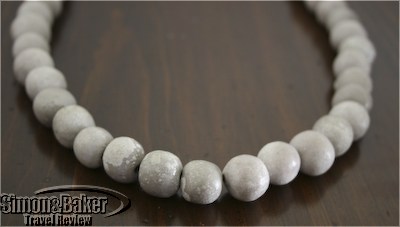
A necklace created by Gift
Three of the staff pursued artistic inspiration in their free time. We found out quite by coincidence and asked to see their work. Shyly, each in turn, displayed examples of his or her efforts. Gift Nyulunga, one of the cooks, made simple bead necklaces out of recycled glass. The large-bead necklaces were available in a limited variety of colors and lengths and were quite affordable starting at about $10.

One of Andre McDonald’s drawings of lion cubs
Andre Mc Donald, or “Mac” as everyone knew him, our affable guide, drew beautiful lifelike wildlife drawings of the animals in the reserve. The Cape Town native who grew up in the Eastern Cape had been selling his art for five years. We had no idea of his hobby and it was only when I overheard someone comment about his work, and after asking several times, that he brought a handful for us to see one afternoon before tea.

Mac’s lion and leopard detailed drawings
“I have had no formal training in art but have always had a keen interest in drawing,” said Mc Donald. “After school I did not draw for many years until I started to work as a ranger on a private game reserve where I began to sketch wildlife. After seeing some of my earlier work, one of my guests encouraged me to develop my skill further.”
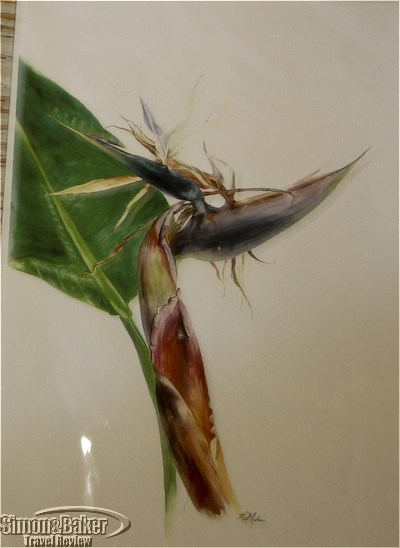
A watercolor by Kerry Michau
His goal is to sketch very realistic representations, in terms of the proportions and postures, of the animals he and his guests often see on the game drives, especially leopards and lions. Each spot on a leopard, for example, is drawn with at least three different pencils to get the depth and texture of the fur just right, he explained.
“I draw from photographs which means that each drawing is true to the original animal. Because I know the animals I draw, I try to capture the character of each individual, in particular the look in their eyes. I look for photographs with an interesting pose or setting.”
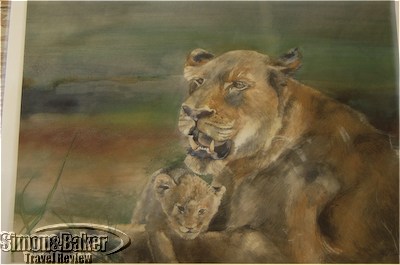
Lion and cub in watercolor
Mac’s pencil drawings had found homes in 22 countries, including United States, Germany, Dominican Republic, Malta, New Zealand and France. The limited edition prints (98 of each) sold for $220 each; originals for $1,000 or $1,500. Overseas delivery required two weeks. He could be reached by email at keriann.mcdonald@gmail.com
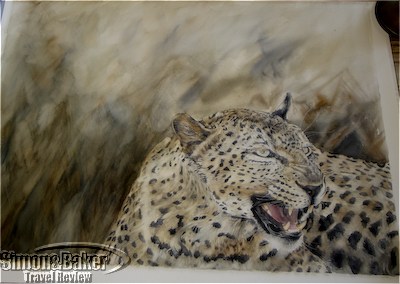
Leopard by Kelly Michau
Kerry Michau, the part time assistant manager, was the third artist. She worked with watercolors, painting the wildlife in the reserve as well as modern abstract pieces and fashion.
For more information about Dulini, Leadwood and Kirkman’s Kamp and other luxury properties in that area visit the Sabi Sand Reserve section of the Simon & Baker Travel Review.
by Editor | Oct 24, 2011 | Accomodations, Ecotourism, New Articles
By Elena del Valle and photos by Gary Cox
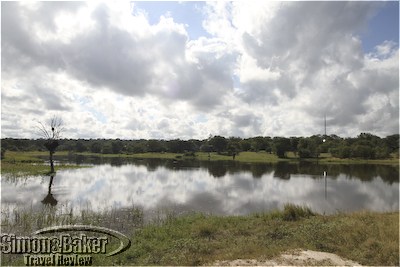
Chitwa Chitwa is located along the shore of a lake
When we first heard of Chitwa Chitwa, a boutique lodge in the northern corner of the famous Sabi Sand Reserve, we wondered about the meaning of the name. It was one of the first questions we asked as we settled in at the lodge. The property was named for an old bull giraffe whose bones made a creaking sound similar to the words chitwa chitwa.
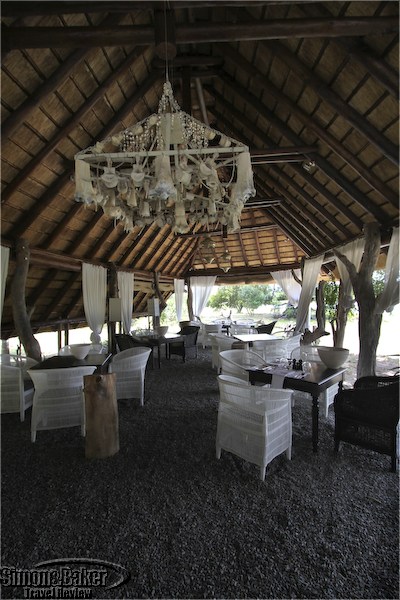
The dining area featured whimsical touches like bone light fixtures
Our stay at the lodge was rewarding in many ways. We loved the lodge’s waterside location and luxurious and spacious rooms with a water view. The Big Five game viewing, in the company of a young and enthusiastic ranger tracker team, was outstanding. A pretty setting and artsy decor along with comfort centered facilities, an intimate and romantic ambiance, a foodie orientation and friendly staff made the property and instant favorite. Visit the Simon & Baker Travel Review Safari Section to learn more about our stay at Chitwa Chitwa.















































